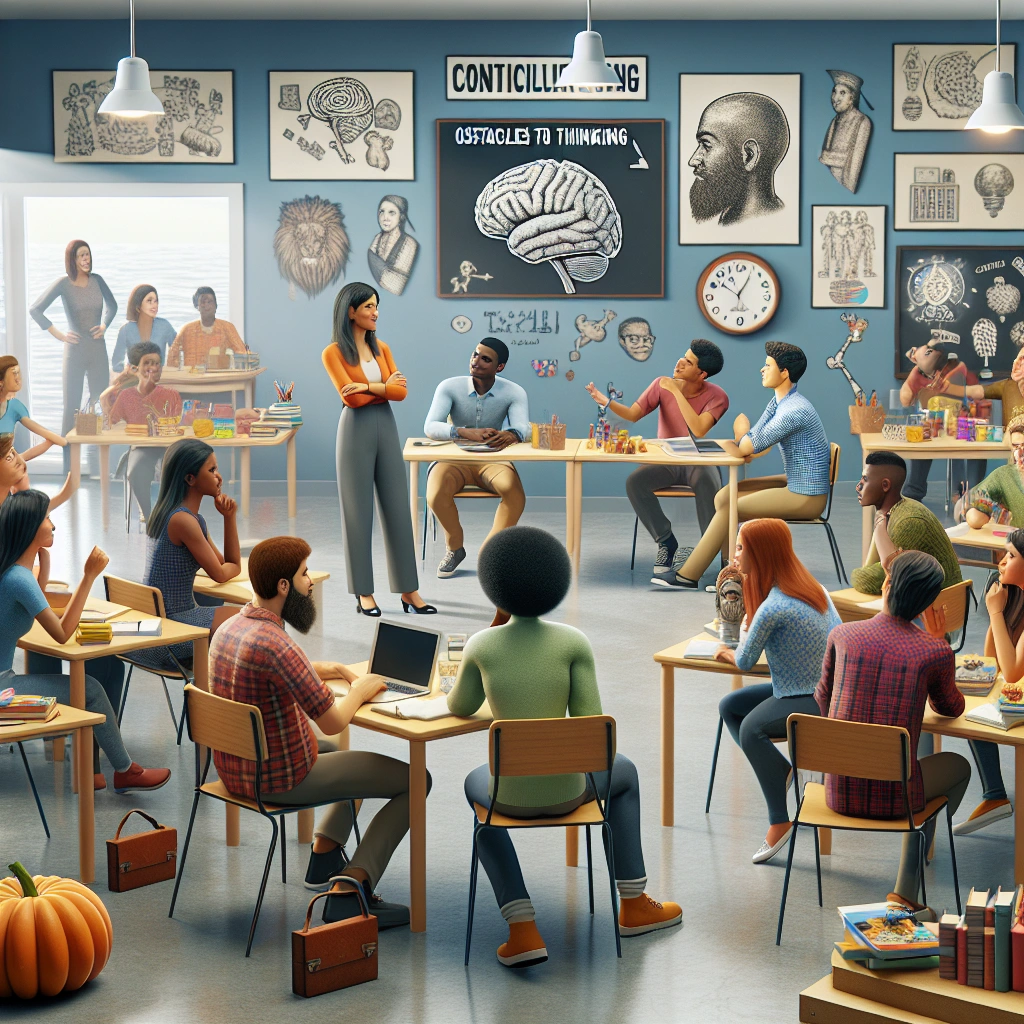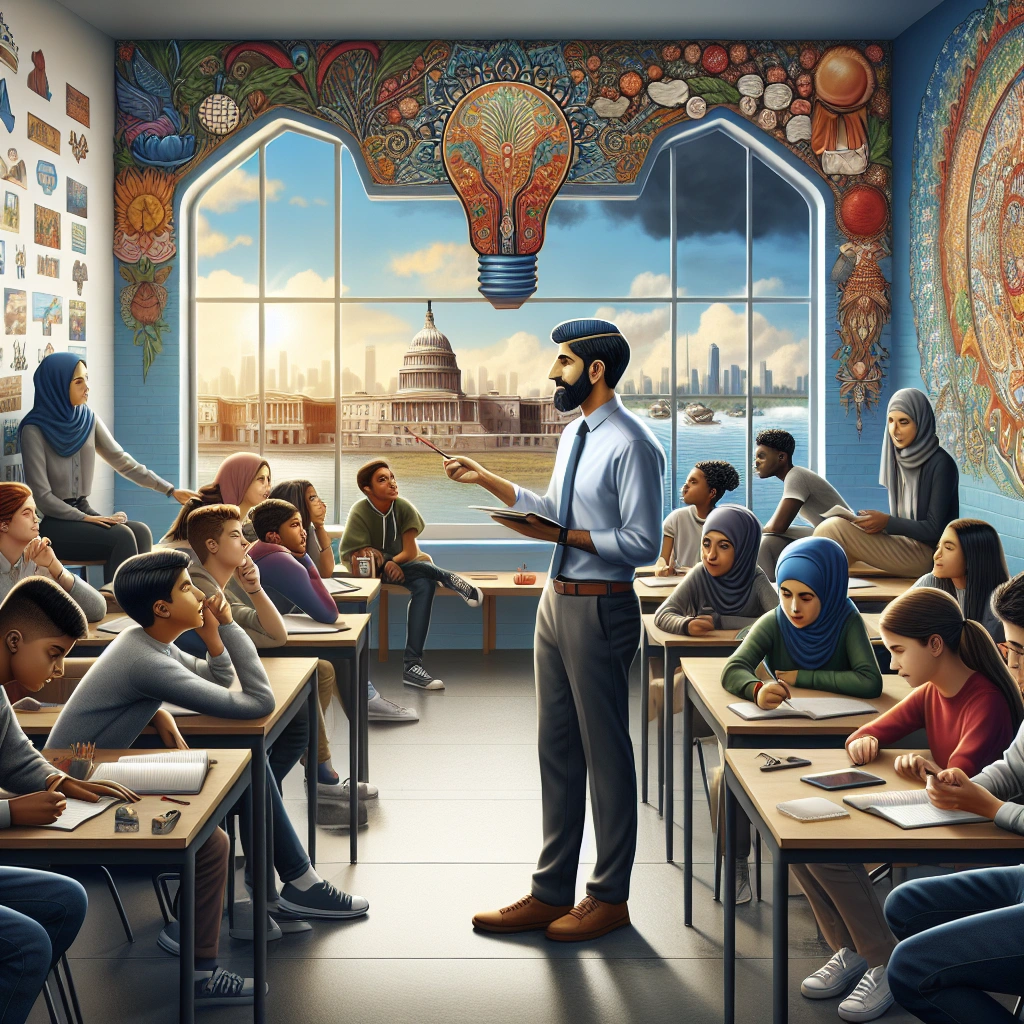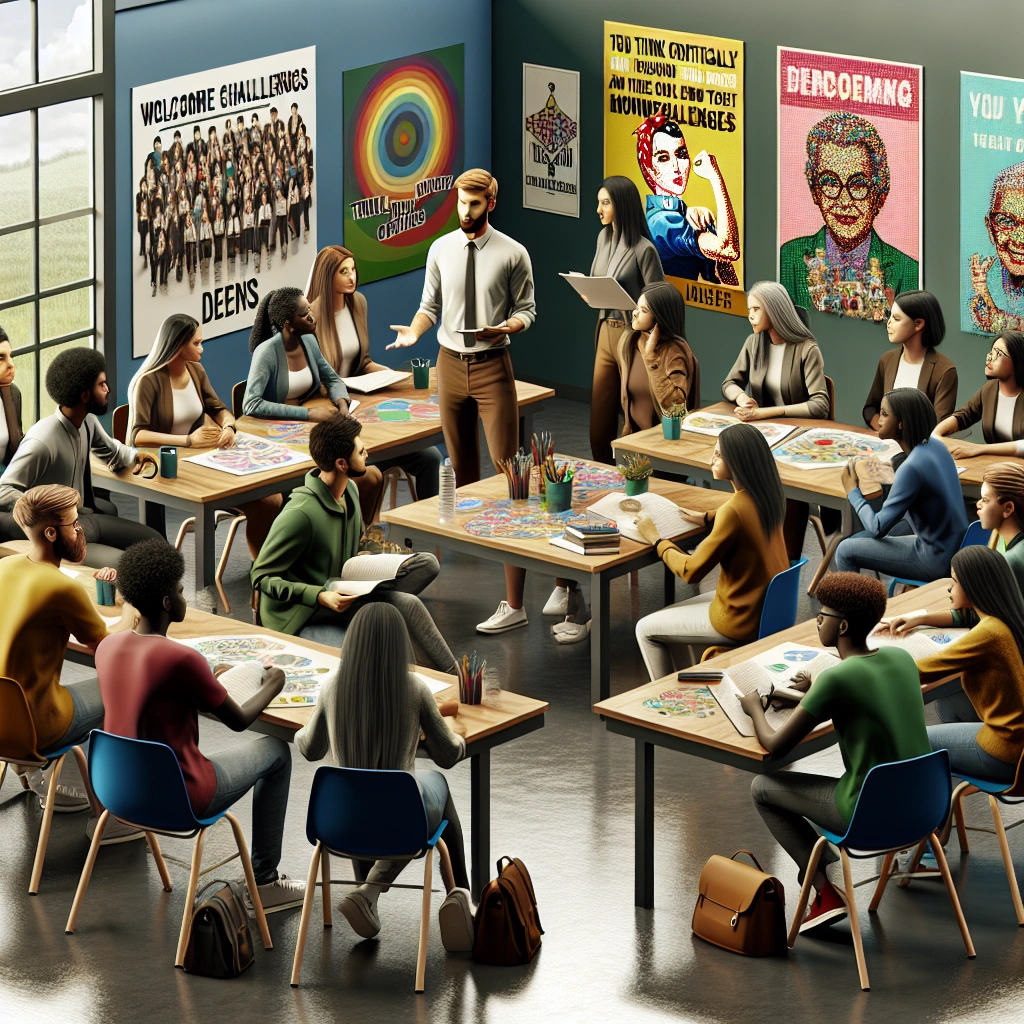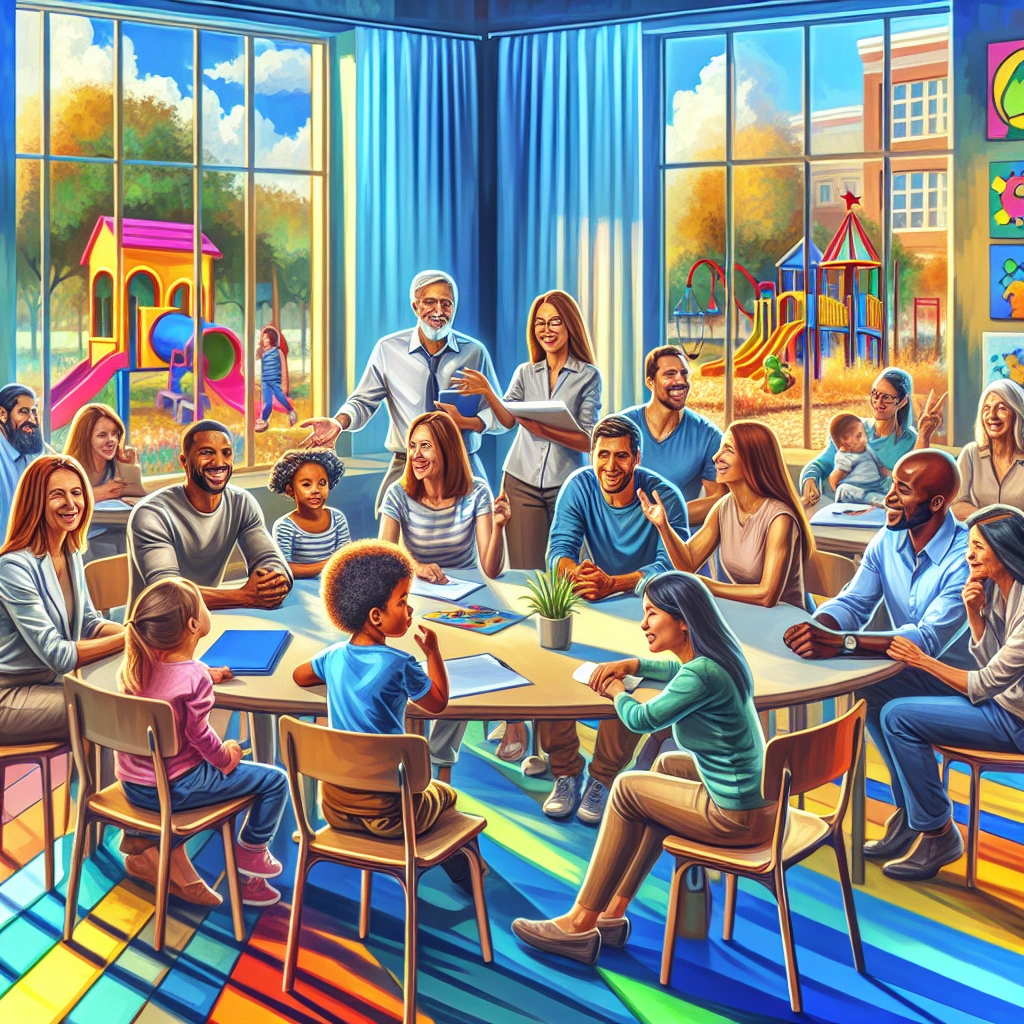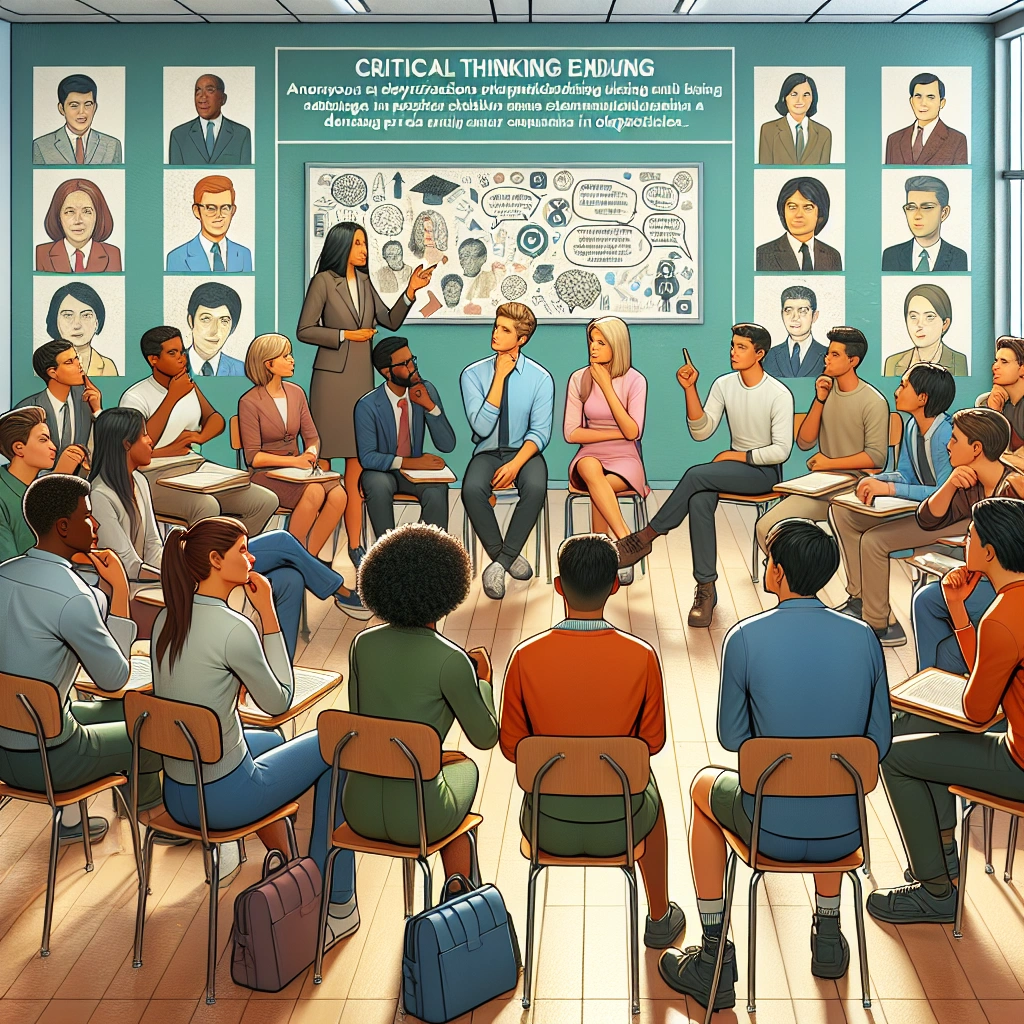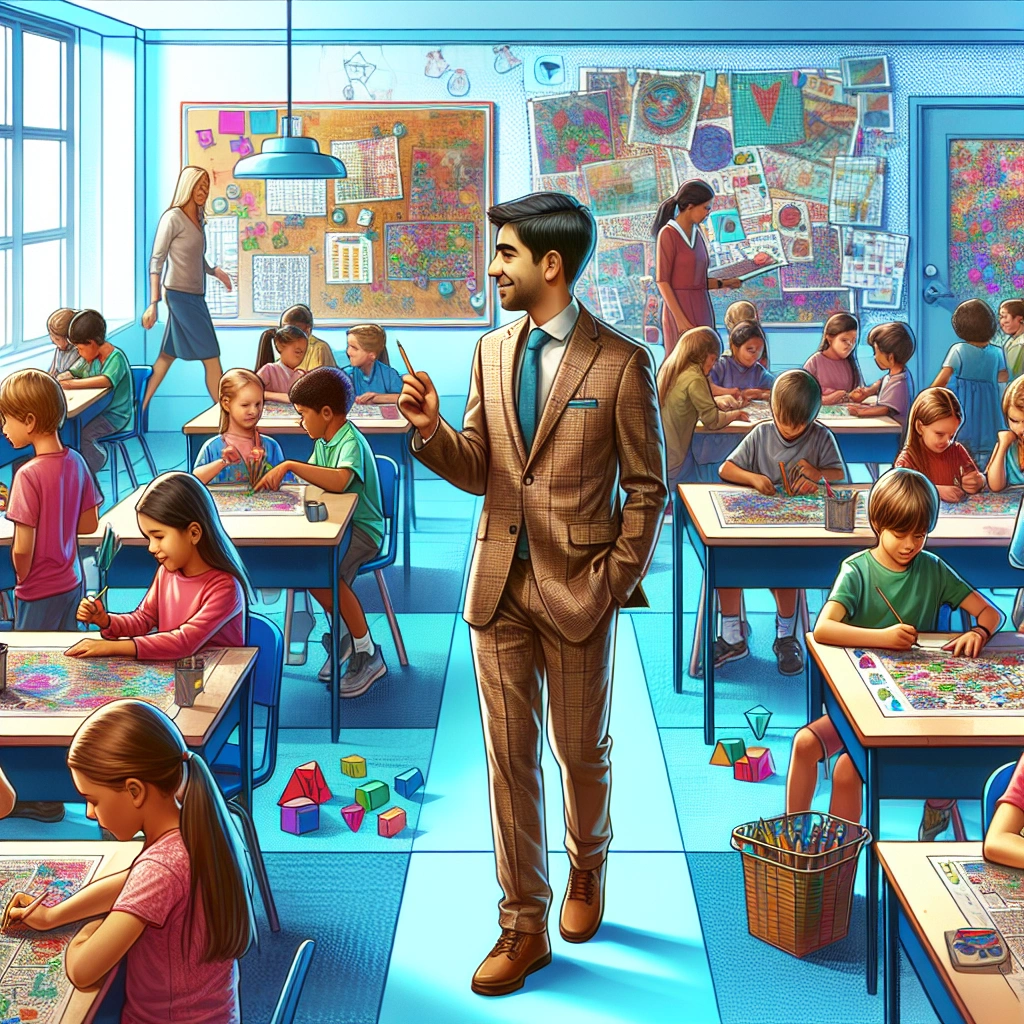Strategies To Develop Critical Thinking In Students


Strategies to develop critical thinking in students are essential for their future success. Educators play a crucial role in implementing these strategies and fostering a mindset of independent and analytical thinking.
By focusing on critical thinking, students can become adaptable, open-minded individuals who can contribute positively to society.
Check out this Youtube video: “5 Critical Thinking Strategies – YouTube” to learn effective methods for developing critical thinking skills in students.
Understanding Critical Thinking
Critical thinking is the intellectually disciplined process of actively and skillfully conceptualizing, applying, analyzing, synthesizing, and/or evaluating information gathered from, or generated by, observation, experience, reflection, reasoning, or communication, as a guide to belief and action. It involves self-guided, self-disciplined thinking which aims to reason at the highest level of quality in a fair-minded way.
This process enables individuals to effectively analyze information, form judgments, and be aware of their biases when evaluating sources.
Definition of critical thinking
The definition of critical thinking is contested but can be understood as careful thinking directed to a goal. It is the ability to think critically, allowing individuals to reflect on and comprehend their perspectives.
This skill assists in determining how to understand the world around them.
Importance of critical thinking in students’ academic and personal lives
Critical thinking is vital for students’ academic and personal development. It is crucial for academic success, enabling students to question statements, make connections, derive knowledge from data, make educated judgments, synthesize information, and deliver insightful presentations.
Moreover, it fosters creativity, self-reflection, and the ability to deal effectively with social, scientific, and practical problems.
The connection between critical thinking and problem-solving skills
Critical thinking involves the ability to analyze and evaluate information to make sound decisions and solve problems effectively. It is instrumental in producing new and innovative ideas, as well as solving complex problems.
Therefore, it is a fundamental skill that prepares individuals to take on the challenges of a globally interconnected world.
Common Barriers to Critical Thinking
Identifying common obstacles to effective critical thinking can be a real game-changer. Whether it’s confirmation bias, reliance on the first piece of information encountered (anchoring bias), or fear of failure and change, these barriers can really hinder the critical thinking process.
It’s crucial to recognize these barriers in order to address and overcome them effectively.
Overcoming personal biases and assumptions is a cornerstone in enhancing critical thinking abilities. Personal biases, obstinance, and group thinking are just a few examples of these obstacles.
By actively working to identify and discard these biases, individuals can significantly enhance their critical thinking skills, leading to more well-rounded and informed decision-making.
Encouraging open-mindedness and diverse perspectives plays a pivotal role in fostering an environment conducive to effective critical thinking. Embracing diverse viewpoints, pushing boundaries, and seeking out different perspectives and experiences can help individuals challenge their assumptions and biases.
This enables them to approach issues from multiple angles, leading to more flexible and open-minded thinking.
| Barriers to Critical Thinking | Tips to Overcome Them |
|---|---|
| Lack of Practice | Practice critical thinking regularly |
| Perceived Inability to Teach It | Develop a growth mindset towards critical thinking |
| Normalcy Bias | Challenge the status quo and be open to change |
| Group-Think | Encourage independent thinking and diverse perspectives |
Incorporating Critical Thinking in the Curriculum
Strategies to integrate critical thinking into lesson plans
One effective strategy to incorporate critical thinking into lesson plans is through the use of Socratic questioning. By asking open-ended, thought-provoking questions, teachers can stimulate students’ critical thinking skills and encourage deep analysis.
Additionally, incorporating debates and discussions into lesson plans can provide students with the opportunity to analyze diverse perspectives and develop their reasoning abilities.
The use of real-world examples to stimulate critical thinking
Utilizing real-world examples can significantly stimulate critical thinking among students. For instance, presenting them with real-life problems or scenarios related to their academic lessons can encourage them to apply their knowledge, think critically, and formulate effective solutions.
Such practical application of concepts enhances their ability to analyze, evaluate, and make informed decisions.
Promoting collaborative learning and discussion
Promoting collaborative learning and discussion in the classroom environment is paramount for fostering critical thinking skills. By engaging in group discussions, students can explore various viewpoints, challenge assumptions, and enhance their analytical skills through interaction with peers.
Active participation in group activities encourages students to articulate their thoughts, defend their viewpoints, and consider alternative perspectives, thereby honing their critical thinking abilities.
| Incorporating Critical Thinking in the Curriculum | |
|---|---|
| Strategies | Socratic questioning, debates, and discussions |
| Real-World Examples | Presenting real-life problems and scenarios |
| Collaborative Learning | Engaging in group discussions and activities |
Creating a Supportive Learning Environment
Fostering a classroom culture that values critical thinking
By creating a classroom culture that values critical thinking, educators can incorporate activities such as Socratic seminars, where students engage in open discussions to challenge each other’s ideas. Additionally, assigning projects that require students to analyze and synthesize information can cultivate an environment that encourages critical thinking.
For example, creating group debate assignments allows students to explore various perspectives and develop their reasoning skills.
Encouraging students to ask questions and challenge assumptions
Encouraging students to ask questions and challenge assumptions involves creating a safe space for inquiry. Utilizing techniques such as the “Question Formulation Technique” can empower students to develop thoughtful questions.
Furthermore, fostering an environment where students feel comfortable challenging assumptions by providing evidence and logical reasoning is essential. For instance, incorporating scenarios that require students to critically evaluate the validity of statements or theories can promote a culture of inquiry.
Providing resources for independent research and exploration
Providing resources for independent research and exploration entails offering access to diverse and reliable sources. Educators can introduce students to credible online databases and library resources that support their independent research projects.
Additionally, organizing field trips to local museums, research institutions, or industry sites can expose students to real-world applications of critical thinking. By providing opportunities for students to explore topics of personal interest and relevance, educators can nurture their capacity for independent inquiry and critical analysis.
Engaging Students in Active Learning
Utilizing interactive teaching methods to promote critical thinking
Interactive teaching methods are vital for engaging students in active learning. Techniques such as group discussions, debates, and role-playing activities are excellent tools for promoting critical thinking.
These methods encourage students to actively participate and engage with the subject matter, leading to a deeper understanding and the development of critical thinking skills.
Incorporating hands-on activities and problem-solving exercises
Incorporating hands-on activities and problem-solving exercises is essential to stimulate critical thinking in students. For instance, science experiments, real-life simulations, and collaborative problem-solving tasks can foster a practical understanding and application of critical thinking skills.
By engaging in these activities, students can develop the ability to analyze and solve complex problems, enhancing their critical thinking capabilities.
Encouraging students to explore and analyze different perspectives
Encouraging students to explore and analyze different perspectives is crucial for nurturing critical thinking. Providing diverse materials, presenting conflicting viewpoints, and facilitating open discussions can broaden students’ understanding and encourage them to think critically about various concepts and issues.
This approach helps students develop the valuable skill of evaluating multiple perspectives and forming well-informed opinions.
Developing Analytical Skills
Teaching students to evaluate information and sources critically can be achieved through interactive activities like a source showdown, where credible sources go head-to-head using the CRAAP Test, or a source credibility scavenger hunt. These activities help students develop the skills to discern reliable information from biased or untrustworthy sources, enhancing their critical thinking abilities.
Enhancing students’ ability to think logically and analytically involves engaging them in subjects like mathematics, which fosters problem-solving skills. Mathematics equips students with the capability to analyze complex equations and arrive at accurate solutions, thereby honing their analytical thinking abilities for real-world applications.
Practicing evidence-based reasoning and argumentation can be facilitated through strategies such as modeling and guided practice, collaborative independent practice, and scaffolded practice. These approaches provide students with the opportunity to articulate and defend their perspectives based on verifiable evidence, enhancing their capability to construct sound arguments supported by relevant data and information.
Using Technology to Enhance Critical Thinking
To enhance critical thinking in students, leveraging digital tools and platforms is paramount. Incorporating interactive online applications like virtual lab simulations and collaborative problem-solving platforms can engage students in a dynamic learning experience.
The use of educational software for coding and robotics fosters logical reasoning and problem-solving skills, stimulating critical thinking abilities.
Incorporating online resources for research and analysis is vital in developing critical thinking skills. Access to scholarly databases such as Google Scholar, JSTOR, and Library of Congress enables students to delve into comprehensive research, fostering analytical thinking and knowledge synthesis.
Employing search engines like BASE allows students to access a wealth of academic web resources for in-depth research and analysis.
Promoting digital literacy and responsible information consumption is essential to empower students as critical thinkers. By emphasizing digital literacy in the classroom, teachers can nurture students’ ability to discern credible sources and understand copyright, instilling a sense of responsibility in information consumption.
Additionally, incorporating the nine elements of digital citizenship in education ensures the development of responsible and ethical online behavior, contributing to a well-rounded digital literacy.
| Online Resources for Research and Analysis |
|---|
| Google Scholar |
| JSTOR |
| Library of Congress |
| PubMed Central |
| BASE |
In a nutshell, by harnessing technology to engage students, providing rich online resources for research, and promoting digital literacy, educators can significantly enhance critical thinking skills among students, equipping them for academic success and real-world applications.
Assessing Critical Thinking Skills
Effective methods of evaluating students’ critical thinking abilities
To effectively evaluate students’ critical thinking abilities, utilizing authentic tasks that require application of knowledge and skills is crucial. For instance, giving students raw data and asking them to analyze or argue based on the data is an effective method.
Additionally, employing validated critical thinking skills tests and critical thinking mindset measures can provide insights into problem-solving abilities, decision-making skills, and consistent internal motivation.
Providing constructive feedback to encourage continuous improvement
Constructive feedback plays a pivotal role in encouraging continuous improvement in critical thinking skills. By offering specific examples and concrete evidence, individuals can understand the areas requiring attention.
Objectivity is essential in feedback, focusing on facts rather than personal opinions. Employing the “observe, don’t interpret” approach and balancing the positive with the negative can further enhance the impact of constructive feedback in promoting critical thinking.
Using assessment data to adapt teaching strategies
Assessment data serves as a valuable tool to adapt teaching strategies. Educators can leverage diverse item types and assessment formats, along with timely performance insights, to promote critical thinking in the classroom.
By planning individual instructional interventions, developing targeted goals, and differentiating instruction based on student readiness, assessment data guides educators in tailored instructional approaches, ultimately enhancing critical thinking skills.
Cultivating a Growth Mindset
Nurturing resilience and perseverance in the face of challenges is crucial for students to develop a growth mindset. Encouraging them to view setbacks as opportunities to learn and grow helps build their resilience.
For instance, providing real-life examples of successful individuals who faced adversity but persevered can inspire students to adopt a similar mindset.
Emphasizing the development of skills through effort and practice is another key aspect of fostering a growth mindset in students. By highlighting the importance of hard work and dedication, educators can instill in students the belief that their abilities can be improved through consistent practice and effort.
For example, showcasing the journey of renowned figures and how they honed their skills over time can reinforce the value of continuous improvement.
Encouraging students to embrace mistakes as opportunities for learning is vital in cultivating a growth mindset. By creating a classroom environment where making errors is seen as part of the learning process, educators can help students overcome the fear of failure.
Offering constructive feedback and sharing stories of personal struggles can demonstrate that mistakes are stepping stones to success.
| S. No. | Strategies to Foster Growth Mindset |
|---|---|
| 1 | Encourage students to share their stories of overcoming challenges |
| 2 | Incorporate role models who exemplify resilience and perseverance |
| 3 | Integrate problem-based learning activities to foster skill development |
Engaging Parents and Guardians
Involving families in supporting the development of critical thinking skills
To involve families in supporting the development of critical thinking skills, engaging them in activities that promote open-ended discussions at home can be highly effective. Encouraging parents to ask their children thought-provoking questions during everyday activities or providing them with game-based learning resources can be impactful.
For example, incorporating critical thinking questions into bedtime stories or discussing real-world problems during family mealtimes can enhance critical thinking in students.
Communicating the importance of critical thinking in student success
Communicating the importance of critical thinking in student success is crucial for parents to understand. Providing them with real-life examples of how critical thinking skills contribute to problem-solving, decision-making, and academic achievement can effectively convey the significance.
Sharing success stories of students who have excelled academically due to their critical thinking abilities can inspire parents to actively support the development of these skills in their children.
Providing resources and activities for parents to reinforce at home
When providing resources and activities for parents to reinforce critical thinking at home, it’s essential to offer a variety of engaging and age-appropriate materials. This could include puzzle books, board games that require strategic thinking, or online platforms with educational games.
Additionally, offering workshops or webinars for parents to understand different ways to support critical thinking development can be beneficial. Moreover, creating a dedicated section on school websites with curated resources and activities can make it easier for parents to access and implement at home.
Emphasizing the Value of Critical Thinking in the Workplace
Connecting critical thinking skills to future career success
Critical thinking lays the foundation for future career success by honing problem-solving, decision-making, and analytical abilities. These skills empower individuals to adapt to complex challenges, innovate, and navigate dynamic work environments, contributing to their professional growth and advancement.
Highlighting the role of critical thinking in various professional fields
In various professional fields, critical thinking is indispensable for informed decision-making, driving innovation, and fostering strategic problem-solving. For instance, in business, critical thinking enables effective risk assessment and strategic planning, while in healthcare, it underpins clinical judgments and diagnostic accuracy.
Preparing students for the demands of the modern workforce
Equipping students with strong critical thinking skills prepares them for the demands of the modern workforce by nurturing their ability to analyze information, think independently, and make sound decisions. These skills are essential for addressing real-world challenges and thriving in diverse professional settings.
Promoting Global Citizenship and Cultural Understanding
Encouraging critical thinking as a tool for understanding diverse perspectives
Encouraging critical thinking amongst students involves promoting an environment where they can freely question, analyze, and understand different viewpoints. This can be achieved through activities like debates, case studies, and role-playing scenarios that encourage students to consider various perspectives on global issues and cultural differences.
One effective strategy is to engage students in real-world examples that challenge their assumptions and encourage them to see issues from different angles.
Fostering empathy and tolerance through critical thinking
Fostering empathy and tolerance using critical thinking entails creating opportunities for students to walk in the shoes of people from diverse backgrounds. By exposing students to different cultural narratives and lived experiences, they can develop a deeper understanding and empathy for others.
Encouraging students to critically analyze media representations of different cultures and advocating for open discussions on global issues cultivates a sense of empathy and tolerance.
Engaging students in global issues and ethical decision-making
Engaging students in global issues and ethical decision-making involves integrating real-world problems into the classroom setting. By addressing complex global challenges, students are prompted to apply critical thinking in exploring ethical solutions.
Creating simulations or scenarios that mirror global dilemmas provides students with opportunities to practice ethical decision-making and understand the impact of their choices on a global scale.
Adapting Strategies for Different Learning Styles
Adapting strategies for different learning styles involves tailoring approaches to accommodate diverse learning preferences. For visual learners, incorporating visual aids like diagrams and videos can enhance understanding.
Auditory learners benefit from interactive discussions and verbal instructions. Addressing the individual needs of students with varied strengths and challenges is crucial.
Providing alternative assignments or assessments can cater to students with different skill levels. Promoting inclusivity and equity in critical thinking education is essential for creating a fair learning environment.
Incorporating diverse perspectives in classroom discussions and using inclusive teaching materials fosters critical thinking about diversity and promotes equitable education.
| Learning Style | Strategy |
|---|---|
| Visual Learners | Use visual aids such as diagrams and videos to enhance understanding. |
| Auditory Learners | Facilitate interactive discussions and provide verbal instructions to cater to auditory learners. |
| Varied Strengths | Offer alternative assignments or assessments to accommodate students with different skill levels. |
| Inclusivity | Incorporate diverse perspectives in classroom discussions and use inclusive teaching materials. |
Addressing Common Misconceptions about Critical Thinking
Clarifying misunderstandings and myths about critical thinking
One widespread misconception about critical thinking is that it solely involves logical reasoning. However, critical thinking goes beyond applying rigid structures; it also incorporates elements such as creativity, curiosity, empathy, and judgment.
It’s not just about following strict rules or formulas. Another common myth is that critical thinking always leads to criticism and disapproval, which is not necessarily the case.
Critical thinking is an open-minded effort to answer questions and test assumptions, aiming for a greater depth of understanding.
Challenging misconceptions about the nature of critical thinking skills
There are misconceptions around the prerequisite of background knowledge for critical thinking to take place. While knowledge is indeed beneficial, critical thinking is more about the ability to assess and analyze information rather than having extensive prior knowledge.
Also, some individuals believe that critical thinking is a natural talent that some possess and others do not. However, critical thinking can be developed and honed through practice and exposure to various problem-solving scenarios.
Providing evidence-based arguments to debunk common fallacies
It’s vital to challenge the misconception that critical thinking is always objective and rational, eliminating emotions and biases. Emotions can be a crucial part of critical thinking, helping individuals connect with problems on a deeper level and consider diverse perspectives.
Additionally, it’s important to debunk the notion that critical thinking is reliant on specific areas of expertise. Critical thinking skills are transferable across different subjects and can be developed through exposure to varying contexts and challenges.
| Common Misconception | Debunking Argument |
|---|---|
| Critical thinking is solely based on logic and reasoning | Critical thinking includes elements of creativity, curiosity, empathy, and judgment |
| Background knowledge is a precondition for critical thinking | Critical thinking involves the ability to assess and analyze information, with knowledge being a beneficial but not essential factor |
| Critical thinking is a natural talent, not a skill that can be developed | Critical thinking can be developed and honed through practice and exposure to various problem-solving scenarios |
Let’s debunk the myths and make way for a more comprehensive understanding of critical thinking.
Remember always; critical thinking is the essential lifeblood of progressive education.
Recommended Amazon Products for Developing Critical Thinking Skills in Students
Here’s a curated list of products that can help educators integrate critical thinking into their curriculum and foster a classroom environment that values this essential skill. These recommendations are based on functionality, price, and positive reviews.
Magnetic Building Blocks


Magnetic building blocks are excellent tools to stimulate critical thinking and problem-solving skills among students. They encourage creativity and analytical thinking while providing a hands-on learning experience.
These blocks offer a wide range of possibilities for exploration, making them an ideal resource for promoting collaborative learning and discussion in the classroom.
Pros and Cons
| Pros | Cons |
|---|---|
| Encourages creativity | Some sets may be expensive |
| Stimulates problem-solving | Risk of small parts for young kids |
| Promotes collaborative learning | Limited to specific age groups |
Educational Board Games


Board games such as chess, Scrabble, and logic-based puzzles provide an entertaining way to develop critical thinking skills. These games help students apply strategic thinking, logic, and reasoning in a fun and engaging manner.
Additionally, they promote analytical skills by encouraging players to evaluate different options.
Pros and Cons
| Pros | Cons |
|---|---|
| Engaging and enjoyable | Require supervision during play |
| Enhances problem-solving skills | Some games have limited replay value Encourages strategic thinking |
Scientific and Educational Kits


Scientific and educational kits, such as robotics kits or chemistry sets, offer hands-on experiences that promote critical thinking. These kits provide opportunities for students to conduct experiments, solve problems, and apply scientific concepts.
They encourage independent research and exploration while fostering a growth mindset.
Pros and Cons
| Pros | Cons |
|---|---|
| Hands-on learning experience | Some kits may require adult supervision |
| Encourages research and exploration | Higher price range for advanced kits Fosters a growth mindset |
Puzzle Games and Brain Teasers


Puzzle games and brain teasers challenge students to think critically and creatively. They require logical reasoning and problem-solving skills, offering a diverse range of challenges to stimulate the mind.
These games can be used to engage students in active learning and develop analytical skills.
Pros and Cons
| Pros | Cons |
|---|---|
| Varied levels of difficulty | Some puzzles may be too challenging |
| Enhances logical reasoning | Not suitable for all age groups Encourages active learning |
STEM Learning Kits


STEM learning kits encompass science, technology, engineering, and mathematics, providing comprehensive tools for developing critical thinking skills. These kits offer a multidisciplinary approach, encouraging students to think critically across various fields.
They support the integration of real-world examples into lesson plans and promote digital literacy.
Pros and Cons
| Pros | Cons |
|---|---|
| Multidisciplinary approach | Higher cost for comprehensive kits |
| Integration of real-world examples | Requires sufficient classroom time Fosters digital literacy and critical thinking |
Top Recommended Product for Developing Critical Thinking Skills in Students
If you’re looking for the best solution to develop critical thinking skills in students, we highly recommend the Magnetic Building Blocks kit. Here’s why:


Magnetic building blocks offer a hands-on learning experience that encourages creativity, critical thinking, and collaborative learning. These blocks are versatile, allowing students to explore a wide range of possibilities, making them an ideal tool for fostering a supportive learning environment. Ready to enhance critical thinking in your classroom? Check out the Magnetic Building Blocks kit today for the best results!


Conclusion
It is evident that several key strategies can be implemented to develop critical thinking in students. These strategies include promoting open-mindedness, encouraging curiosity, and teaching problem-solving skills.
By focusing on these areas, educators can effectively nurture critical thinking in their students, leading to more independent and analytical learners.
Furthermore, the ongoing importance of cultivating critical thinking skills in today’s learners cannot be overstated. With the rapid advancements in technology and the increasing complexity of global issues, students need the ability to think critically in order to navigate the challenges they will face in the future.
Therefore, it is crucial for educators to continue implementing these strategies in their teaching practices to ensure that students acquire the necessary skills to thrive in the 21st century.
The development of critical thinking in students plays a vital role in preparing them for success in both their academic and personal lives. By emphasizing these strategies and prioritizing the cultivation of critical thinking skills, educators can empower students to become active and engaged thinkers who are capable of making informed decisions and solving complex problems.
Fostering critical thinking in students is essential for their long-term success and should remain a top priority in education.


